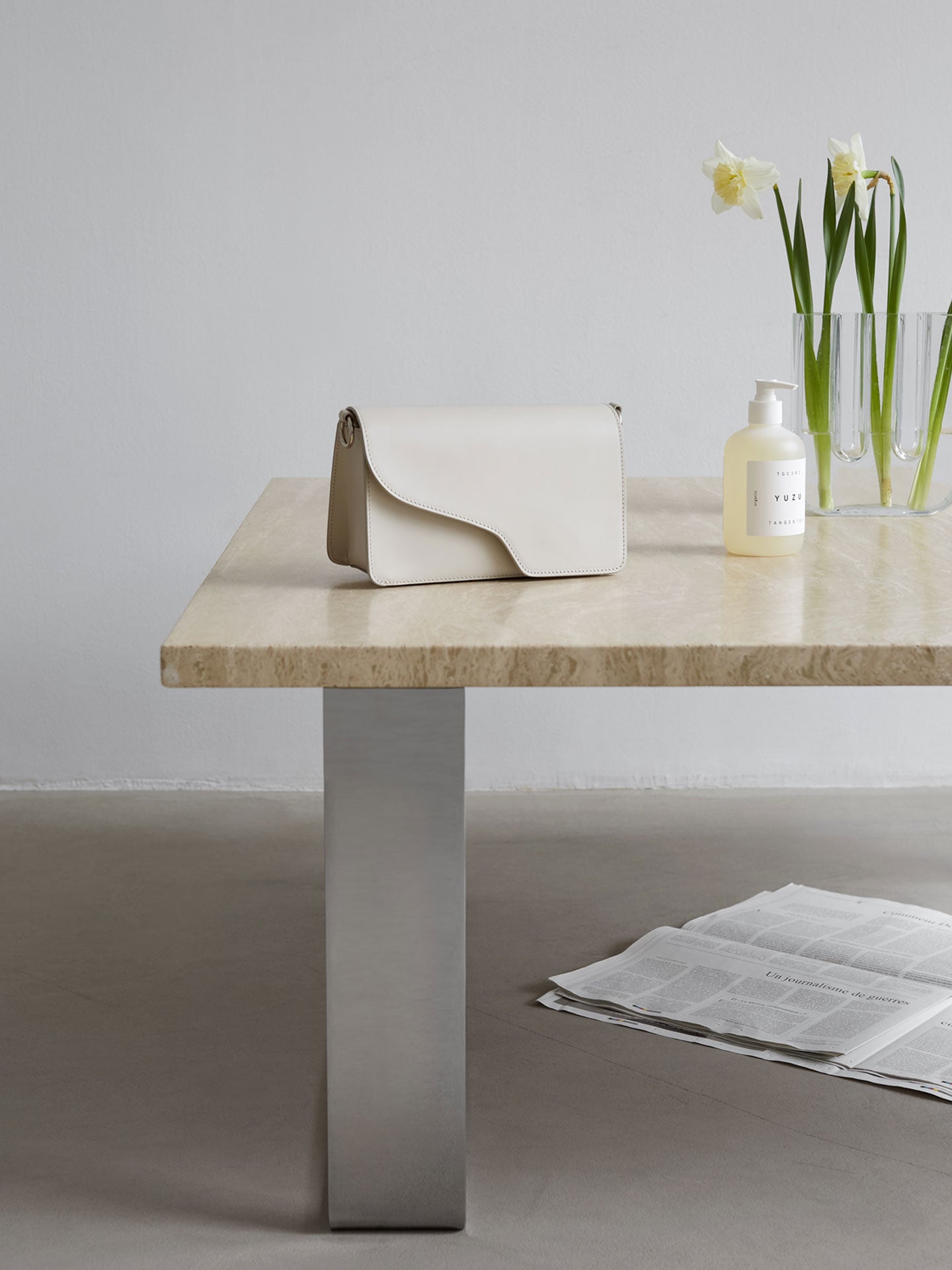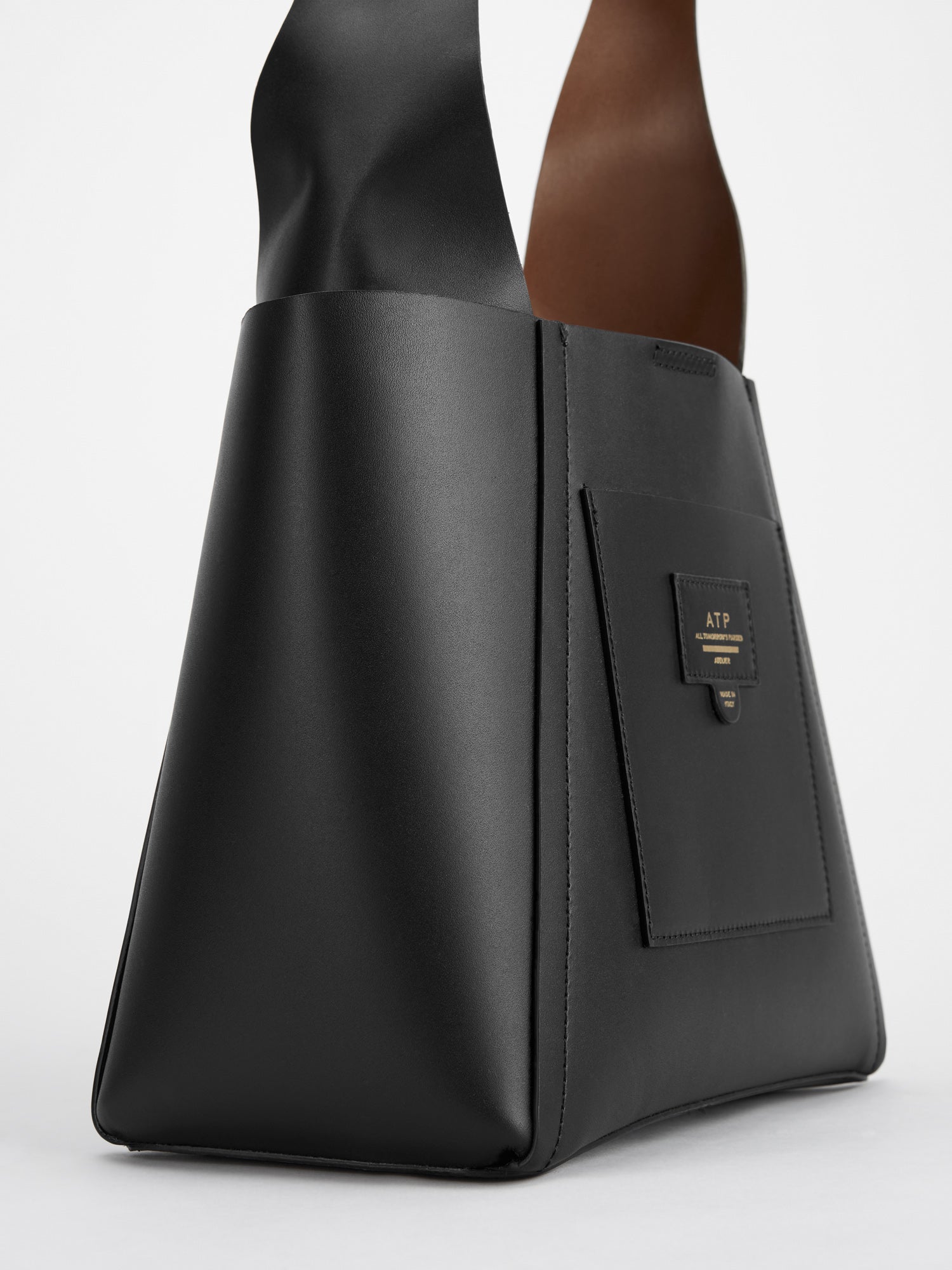CARE GUIDE
We feel like there is so much pressure to reinvent oneself with every season. This is unfortunate, since ATP Atelier products are meant to be worn for many years. So obviously, we’re aiming to change this. This care guide is our first step! Also browse our care products here.
Shoes
Leather soles
Most ATP Atelier footwear has untreated leather soles. If you, like us, live in a climate that more often than not is wet due to rain or snow, we recommend to protect leather soles with a 1-2 mm rubber sole. This will protect your sole, waterproof it, and make it non-skid. If your leather soles get wet, allow them to dry naturally. Support your local shoe maker/repair shop!
Keep the shape
We encourage you to switch between different shoes from day to day. They need a little rest every week. We’re sure you can relate. And if you want the shoes to maintain their shape and contour, use a shoe block whenever you’re not using them. Exposure to water will create spots. However, the patina created by daily wear and tear will fade and change over time.
Shoe blocks
Use shoe blocks if you are looking to wear your shoes for many seasons. This might sound silly, but make sure to always zip all zippers (if your shoes has them ofc) all the way up and down. If you don’t, it puts a lot of strain on the zipper which might cause it to break or get stuck.
Suede shoes
Suedes and nubucks are aniline leathers which means that they do not have a protective finish. This in turn means they are not water resistant and sensitive to stubborn staining. We recommend that you spray these materials with a suitable suede protector prior to use. Should your suede pieces come into contact with water, they should be blotted with a dry cloth to absorb any excess liquid asap. A soft rubber suede brush can be used to lightly clean away loose dirt, however due to the delicate and fibrous quality of these materials we advise against rubbing too vigorously as this may result in damaging the surface appearance. Please be aware, due to the nature of this material group, there may be a minimal amount of color transfer with initial use.
Keep your items clean
The easiest way to keep your items feeling like their best self, is to simply keep them clean. This will also make them last longer. Brush the leather with a damp cloth (not soaked) from time to time. They're dirtier than you think, promise!
Grease
The most common mistake people make when taking care of their leather items is they use too much fat, to the point where the material can’t absorb it and is damaged instead. If your shoes feels dry or dull, start small, you need less grease than you probably think! Apply a small amount of cream on a cotton cloth and work it in to the leather in circular motions, 2 – 3 cm at a time, until the cream is fully absorbed. If your leather sole is starting to wear out – apply some there too.
Avoid water
Most of our products are in a vegetable tanned vacchetta, which is a material very sensitive to water. A damp cloth is totally okay, but never running water. If you are caught in a thunderstorm and your boot is drenched, let it dry for a couple of days preferably with a shoe block or a bunch of paper inside. Without that, it runs the risk of losing its original shape.
Bags & Small leather goods
Keep the shape
We encourage you to switch between different bags from day to day. They need a little rest every week. We’re sure you can relate. Exposure to water will create spots. However, the patina created by daily wear and tear will fade and change over time.
Dust bags
Whenever you are not using your ATP Atelier bag, keep it in its dust bag. This prevents you or other items from accidentally scratching it and maintains its shape and contour. Depending on the color, the leather can also be sensitive to direct sunlight for longer periods of time.
Keep your items clean
The easiest way to keep your items feeling like their best self, is to simply keep them clean. This will also make them last longer. Brush the leather with a damp cloth (not soaked) from time to time. They're dirtier than you think, promise!
Grease
The most common mistake people make when taking care of their leather items is they use too much fat, to the point where the material can’t absorb it and is damaged instead. If your bag feels dry or dull, start small, you need less grease than you probably think! Same logic as with your skin care. Apply a small amount of cream on a cotton cloth and work it in to the leather in circular motions, 2 – 3 cm at a time, until the cream is fully absorbed. Avoid using colored leather cream on bags, as there is a risk excess cream discoloring your clothing.
Avoid water
Most of our products are in a vegetable tanned vacchetta, which is a material very sensitive to water. A damp cloth is totally okay, but never running water. If you are caught in a thunderstorm and your bag is drenched, let it dry for a couple of days preferably with a bunch of paper inside. Without that, it runs the risk of losing its original shape.

OUR MATERIALS
All our products are made by hand and with natural materials which means no bags or shoes are exactly identical.
Calf leather
Just as our vacchetta leather, our calf leather is tanned with natural vegetable tannins, most commonly from bark and leaves that does not disrupt the natural ecosystem. The only difference is that this material has a softer touch.
However, the life span of these pieces stretches over many seasons. The material is very durable and luxe, the sustainable tanning process does not in any way compromise the quality of the leather. As we shape this material into timeless shapes, we create the ultimate style investments.
Canvas
Crafted from a premium blend of natural cotton and linen, our canvas combines elegance and durability. Its stunning off-white hue offers a timeless, chic aesthetic, while its water-resistant finish adds practicality to its sophisticated appeal. To maintain its beauty, simply wipe clean with a damp cloth—an effortless solution for those who value style and functionality.
Grained calf leather
The is one of our softest and smoothest leathers. To enhance the natural grain of the calf leather, the hides are embossed while they are still wet to have a deeper imprint. The process is then finished by coating the leather to protect it, making it supple yet resilient.
Naplak leather
Our Naplak material is a patent leather with a stuinning glossy finish, soft temper and wrinkled look.
Nappa leather
Chrome free nappa leather is, as the name suggests, a material that has been manufactured without using chromium in the tanning process.
The chrome free nappa is one of our softest and smoothest materials. It is also very durable and luxe, the sustainable tanning process does not in any way compromise the quality of the leather. Most leather produced in the world is chrome treated so this material is also, in many ways, kind of unique. Some would even say extra.
Pony
Our short haired leather (we call it pony) is really created from cow hides. It is created from the hairy side of the hide which is shaved to resemble a horse's fur. In other words, it’s not real pony. There’s no need for special care products to make sure that these hairy leather products keep their fur soft and in good condition. Although this hair is naturally water-resistant, it may become damaged by rough use. Go to our care guide to learn how to look after your pony hair products to make them last a lifetime.
Printed leather
We love the look of exotic animal prints, but have chosen to not use any real animal skins of that kind but instead use metal-free calf leather. Just like our other metal-free leathers this calf skin is tanned and finished without the use of any heavy metals or harmful chemicals. To get this look the leather is embossed using metal plates and a combination of high pressure and heat. These embossed leathers feature an authentic replica texture of a range of reptiles and exotic animals, such as crocodile, snake and lizard.
The process is finished with a coating of the leather that also serves as a protector, making it more durable and less sensitive to scratches than our vegetable tanned vacchetta. It is also much less sensitive to water and easy to wipe clean.
Saffiano leather
The name Saffiano comes from the cross hatch print that is pressed into the leather. The distinctive markings on this leather consist of a series of diagonal lines to create a crosshatch pattern that renders the leather very resistant to stains. It is more durable and less sensitive to scratches than our vegetable tanned vacchetta leather. It is also much less sensitive to water and easy to wipe clean.
Many high-end fashion houses use Saffiano leather for its many positive attributes. The qualities of Saffiano leather were invented by Mario Prada, who first invented and patented the technique.
Shearling
Our shearling comes from very lovely lambs in Sardegna. That’s Italian for Sardinia.
ATP Atelier is a fur-free brand. This means that our shearling comes from reclaimed hides from the food industry. It is not derived from animals raised for fur production. Simply put, the only thing that sets our shearling apart from our other materials, like vacchetta and nappa is that these hides are never shaved.
Our shearling is produced by San Lorenzo's oldest and most prestigious Italian tanneries.
Suede
Our Tuscan suede is characterized by a textured surface that is durable and comfortable, supple and soft. It’s luxurious without being delicate or sensitive. Due to its relative thinness, suede is generally more flexible and stretchier than other leathers making it very comfortable forming perfectly to your foot. Suede is also a very durable material, and by taking care of your suede products in the right way you can make them last a lifetime.
Vacchetta leather
The Italian artisanal tradition of vegetable tanning has been handed down from generation to generation – and if it ain’t broke, don’t fix it! The vacchetta leather is both beautiful and supports a more sustainable fashion cycle. Here are a few technical, but oh so important, facts.
Leather products treated with natural vegetable tannins are biodegradable and can be easily discarded at the end of their natural life.
The tanneries we employ have made huge investments in depuration systems and waste recycling, to further promote sustainable environmental manufacturing practices.
Many of the substances used during the tanning process are recovered, recycled and reused. Vegetable-tanned leather does not contain any toxic substance such as azo-dyes, nickel, PCP or chrome VI.
